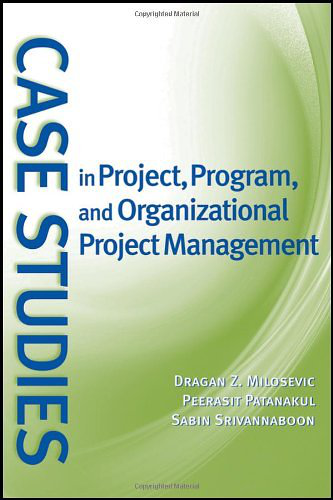And peerasit patanakulthe program map sabin srivannaboon


IN PROJECT, PROGRAM, AND ORGANIZATIONAL PROJECT MANAGEMENT
D R A G A N Z . M I L O S E V I C
John Wiley & Sons, Inc.
This book is printed on acid-free paper.
Limit of Liability/Disclaimer of Warranty: While the publisher and the author have used their best efforts in preparing this book, they make no representations or warranties with respect to the accu-racy or completeness of the contents of this book and specifi cally disclaim any implied warranties of merchantability or fi tness for a particular purpose. No warranty may be created or extended by sales representatives or written sales materials. The advice and strategies contained herein may not be suitable for your situation. You should consult with a professional where appropriate. Neither the publisher nor the author shall be liable for any loss of profi t or any other commercial damages, including but not limited to special, incidental, consequential, or other damages.
For general information about our other products and services, please contact our Customer Care Department within the United States at (800) 762-2974, outside the United States at (317) 572-3993 or fax (317) 572-4002.
p. cm.
Includes index.
To my parents, Arun and Soisalinee; my wife, Severine; and my children, Ananya and Yanat
—Peerasit PatanakulTo my father, Sabieng, my mother, Songsee,
and my lovely wife, Jany
—Sabin SrivannaboonAcknowledgments xxii
PART I: CASE STUDIES IN PROJECT MANAGEMENT
Jovana Riddle
● A RobustArm Global Industries’ Sledgehammer 10
Dragan Z. Milosevic, Peerasit Patanakul, and Sabin Srivannaboon
● The Project Hand-off Method 17
● The Jamming 26
Dragan Z. Milosevic, Peerasit Patanakul, and Sabin Srivannaboon
Sabin Srivannaboon
● Waterfall Software Development 36
Rabah Kamis
CHAPTER 4 PROJECT INTEGRATION MANAGEMENT 55
● WRQ Software Development 73
Peerasit Patanakul and Michael Adams
Wilson Clark and Dragan Z. Milosevic
● Project Anatomy 92
● How Long Does It Take to Catch a Fish—TAD? 105
Ferra Weyhuni
● The Rolling Wave 121
Dan Itkes
| ix | |||
|---|---|---|---|
| ● | |||
| ● | |||
|
|||
| ● |
|
||
| ● | |||
|
|||
| ● |
|
||
| ● | |||
| ● | |||
|
|||
| ● |
|
||
| ● | |||
|
|||
| ● |
|
||
| ● | |||
| ● | |||
|
|||
|
|||
| ● | |||
| ● | |||
|
|||
| ● |
|
||
● ● |
|
|---|
CHAPTER 12 PROJECT PROCUREMENT MANAGEMENT 247
● |
|---|
PART II: CASE STUDIES IN PROGRAM MANAGEMENT CHAPTER 13 THEMES OF PROGRAM MANAGEMENT 257
● ● |
|---|
CHAPTER 16 PROGRAM EXECUTING PROCESS 297
|
|---|
| xii | ● | CONTENTS | |
|---|---|---|---|
| ● | |||
|
|||
|
PART III: CASE STUDIES IN ORGANIZATIONAL PROJECT MANAGEMENT
|
|---|
Contents xiii
CHAPTER 21 COMPETENCIES OF PROJECT MANAGERS AND THE PROJECT MANAGEMENT OFFICE 407
|
|---|
CHAPTER 23 ORGANIZATIONAL CULTURE AND PROGRAM CULTURE 467
CHAPTER 24 ORGANIZATIONAL PROJECT MANAGEMENT IN ACTION 481
Preface
Traditionally, the use of case study has been largely emphasized in many disciplines. People use cases in different manners from theory building, to theory testing, to description, or even to simple explanation. Nevertheless, learning is always one ultimate goal in which we center our attention on the gravity of the problems and issues in the case, regardless of any purpose. In particular, the learning occurs when we dissect the case, identify issues or problems in it, and then discuss or solve them.
xvi PREFACE
different expertise varying from engineers to industrial psychologists, to quality computer experts, to software programmers, to businesspersons ’ service provid-ers, and to organization specialists. These cases are factual from real people and actual companies in different industries, settings, or cultures with diverse sizes and types of projects, although we used fictitious names to conceal their identities. Our goal is to highlight the applications and practices of project management, program management, and organizational project management in real - world settings.
|
|---|
This book offers a number of case studies that demonstrate effective use of project and program management methodologies, as well as organizational proj-ect management practices. Drawn from a variety of industries and regions, the case studies capture real-world situations, challenges, best practices, and lessons learned both from successful and not-so-successful perspectives. In order for our readers to best learn project management, we have categorized and arranged our cases into two different dimensions: case types and parts.
CASE TYPES
While the case types are different, their structure across different parts is similar. Each case includes an introduction, main body, conclusion, and discus-sion items.
PARTS
|
|---|
|
|
||||||
|---|---|---|---|---|---|---|---|
| Cases are organized based on the PMBOK Guide. | Cases are organized based on the Standard for Program Management. |
||||||
|
|||||||
| Read and understand the cases for specific management outcome. | |||||||
The Principles of Management
xxi
Acknowledgments
xxii

With a competitive business environment, many organizations nowadays use projects not only to build structures, to implement changes, or to introduce new products, but also as a way to put strategies into action. Despite multiple meanings of a project, the one defined by Project Management Institute (PMI) is perhaps the most widely known definition. According to PMI, a project is a temporary endeavor undertaken to create a unique product, service, or result. 1 With its tem-porary nature, a project is often perceived as standing on the opposite spectrum of business as usual; it is often referred to as an “ operation ” by project manage-ment scholars. As projects differ from operations, managing projects therefore
1A Guide to the Project Management Body of Knowledge , 4th ed., Project Management Institute, 2008, p. 5.






